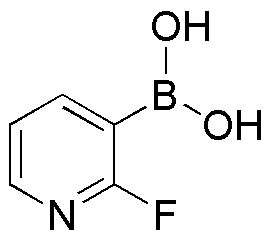2-Fluoropyridine-3-boronic acid is widely utilized in research focused on:
- Pharmaceutical Development: This compound serves as a crucial building block in the synthesis of various pharmaceuticals, particularly in the development of targeted therapies for cancer and other diseases.
- Organic Synthesis: It is employed in cross-coupling reactions, such as Suzuki-Miyaura coupling, to create complex organic molecules, making it invaluable for chemists in the field of organic synthesis.
- Material Science: The compound is used in the production of advanced materials, including polymers and coatings, that require specific chemical properties for enhanced performance.
- Agricultural Chemistry: It plays a role in the development of agrochemicals, contributing to the formulation of herbicides and pesticides that are more effective and environmentally friendly.
- Analytical Chemistry: This chemical is utilized in various analytical techniques, aiding researchers in the detection and quantification of other compounds in complex mixtures.
General Information
Properties
Safety and Regulations
Applications
2-Fluoropyridine-3-boronic acid is widely utilized in research focused on:
- Pharmaceutical Development: This compound serves as a crucial building block in the synthesis of various pharmaceuticals, particularly in the development of targeted therapies for cancer and other diseases.
- Organic Synthesis: It is employed in cross-coupling reactions, such as Suzuki-Miyaura coupling, to create complex organic molecules, making it invaluable for chemists in the field of organic synthesis.
- Material Science: The compound is used in the production of advanced materials, including polymers and coatings, that require specific chemical properties for enhanced performance.
- Agricultural Chemistry: It plays a role in the development of agrochemicals, contributing to the formulation of herbicides and pesticides that are more effective and environmentally friendly.
- Analytical Chemistry: This chemical is utilized in various analytical techniques, aiding researchers in the detection and quantification of other compounds in complex mixtures.
Documents
Safety Data Sheets (SDS)
The SDS provides comprehensive safety information on handling, storage, and disposal of the product.
Product Specification (PS)
The PS provides a comprehensive breakdown of the product’s properties, including chemical composition, physical state, purity, and storage requirements. It also details acceptable quality ranges and the product's intended applications.
Certificates of Analysis (COA)
Search for Certificates of Analysis (COA) by entering the products Lot Number. Lot and Batch Numbers can be found on a product’s label following the words ‘Lot’ or ‘Batch’.
*Catalog Number
*Lot Number
Certificates Of Origin (COO)
This COO confirms the country where the product was manufactured, and also details the materials and components used in it and whether it is derived from natural, synthetic, or other specific sources. This certificate may be required for customs, trade, and regulatory compliance.
*Catalog Number
*Lot Number
Safety Data Sheets (SDS)
The SDS provides comprehensive safety information on handling, storage, and disposal of the product.
DownloadProduct Specification (PS)
The PS provides a comprehensive breakdown of the product’s properties, including chemical composition, physical state, purity, and storage requirements. It also details acceptable quality ranges and the product's intended applications.
DownloadCertificates of Analysis (COA)
Search for Certificates of Analysis (COA) by entering the products Lot Number. Lot and Batch Numbers can be found on a product’s label following the words ‘Lot’ or ‘Batch’.
*Catalog Number
*Lot Number
Certificates Of Origin (COO)
This COO confirms the country where the product was manufactured, and also details the materials and components used in it and whether it is derived from natural, synthetic, or other specific sources. This certificate may be required for customs, trade, and regulatory compliance.


